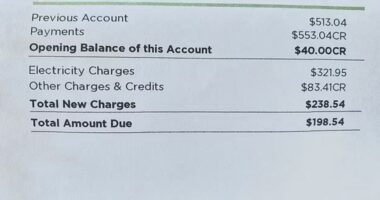MARTIN Lewis has issued a warning to millions of Brits who are at risk of a £100 fine.
The Martin Lewis Money Show, returned on Tuesday for the latest episode of its 12th season.
During the show, the MoneySavingExpert founder explained that households have just a week left (now two days) to fill out their their self-assessment tax returns.
Millions of people must fill in their tax return, before the January 31 deadline.
Martin urged Brits to not leave the form until the last minute because it could get delayed in HMRC backlog.
People who miss the self-assessment deadline face a penalty of £100 if their tax return is up to three months late.


Further fines of £10 a day are applied after three months, up to a maximum of £900.
For payments late by six months, you’ll be fined 5% of the tax you owe or £300, whichever is greater.
You’ll need to submit a tax return if you were self-employed with income of more than £1,000 or if HMRC have said you underpaid on tax last year.
The warning also includes those who are high earners, earned income from abroad, or earned money on savings and investments.
Most read in Money
Speaking on the show Martin said: “If you don’t do it you risk a £100 fine and if you haven’t done the payments that you need, you’ll be charged interest on that.
“Because, people can be charged interest on payments that they haven’t made to the tax office.
“If you have been sent one of these, you have to do it, even if you don’t think you should, you have to do it.
“Please, it’s already very late, do not leave it to the last minute.
“I’ve got reports that the HMRC helpline is clogged, get this done today or tomorrow because if you’ve got a problem it is going to be too late to get it sorted out.”
Tips to fill in your self-assessment tax return
Here are our tips to getting through your online self-assessment and avoid getting hit with the £100 fine.
Be prepared
Before you can complete and submit your tax return, you’ll need to have a so-called unique taxpayer reference (UTR) and activation code from HMRC.
This can take a while to receive, so if it’s the first time you’re completing self-assessment, make sure you register online immediately and ask HMRC for advice.
To sign in or register visit the self Assessment tax return section of HMRC’s website.
If you’ve already signed up for self-assessment, you can find your UTR on relevant letters and emails from HMRC.
HMRC accepts your payment on the date you make it, not the date it reaches its account – including on weekends.
Gather all the information and documents you need
Gather all of the expenses and documents relating to your income.
Having these to hand will help you race through the process.
This includes your 10-digit Unique Taxpayer Reference (UTR) and your National Insurance number.
The form also includes include bank statements and details of untaxed income from the year, which might involve finding your P60 (if you earned more than £8,500), your P11D (which has information about expenses and benefits), and payslips.
If you’re self-employed, you’ll need records of your income and receipts for expenses.
You will also need interest statements from banks and building societies, and details of pension contributions made.
If you need third parties to provide you with statements and documents, you should contact them right away as this can take time.
Fill in the form
Once you log in to complete your online tax return, you should begin by checking your personal details.
You should then choose to fill in the sections that fit your circumstances.
With an online tax return, HMRC’s system will react to the answers you give as you put them in.
This might mean, for example, that sections that are not relevant to you are removed.
When filling in the figures, the online system gives reminders about where you can find the information to fill in particular sections.
As a self-assessment taxpayer you need to report everything you’ve earned over the tax year from April 6, 2021 to April 5, 2022.
This includes income from employment, self-employment, income from property, and interest and gains on your savings and investments.
Remember to also claim all the deductions you are entitled to, including gift aid on your charitable contributions and membership costs for zoos and museums.
If you are a member of a professional body that is required for your employment, you can include the cost of the subscription as a deduction.
Those who are self-employed can also claim back the running costs of a car, but not the cost of buying one.
Your tax will be calculated automatically as your fill in the return.
Take your time and double-check your return
Once you’ve filled in the empty fields, check all your numbers thoroughly before pressing submit.
When filing online, you can save your tax return at any time, so if you need to go away and double check your figures, do so.
When you are happy that everything is correct, you can press send.
If you need to change your tax return after you’ve filed it, you can do so within 12 months of the original deadline or you can write to HMRC for any changes after that.
Don’t be afraid to ask for help
If you need help with your return, visit the GOV.UK website or call the helpline on 0300 200 3310.
There are HMRC guidance notes and manuals online, but if you’re struggling you could seek advice from an accountant or tax adviser.
Consumer group Which? also offers an online self-assessment tool that does the calculations for a tax return and submits it directly to HMRC.
You have to fork out £10 for the service though, or £36 if you’re not a member.
For a more tips and help see our handy guide on how to fill out the tax return.


Do you have a money problem that needs sorting? Get in touch by emailing [email protected]










